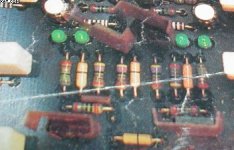They were used as trace jumpers for single side boards.
With single side boards it's not always possible to avoid crossing traces.
Looks much better, easier for production.
Japanese amp boards often had long jumper wires.
The fancier ones had/have copper overhead strips for powersupply rails.
With single side boards it's not always possible to avoid crossing traces.
Looks much better, easier for production.
Japanese amp boards often had long jumper wires.
The fancier ones had/have copper overhead strips for powersupply rails.
jacco vermeulen said:They were used as trace jumpers for single side board
trace jumpers? like if a pcb is suppose to have a resistor but the design was changed and the resistor was removed. you place a zero ohm resistor in its place?
I bought some just for the sake of having some.
that's the same reaction that everyone I showed it to.......
from what I know, it was made for automated machines where the machine was designed to handle resistors but not plain wires........not sure though. just a guess.........
that's the same reaction that everyone I showed it to.......
from what I know, it was made for automated machines where the machine was designed to handle resistors but not plain wires........not sure though. just a guess.........
djQUAN said:I bought some just for the sake of having some.
that's the same reaction that everyone I showed it to.......
from what I know, it was made for automated machines where the machine was designed to handle resistors but not plain wires........not sure though. just a guess.........
it's only 6 cents in mouser so it's not much but leads cut from resistors are just as good
it does look and sound cool though
Deceive the audience by adding a couple of color stripes
(great thing about digital cameras is that you can read every component and the schematic from a picture, this one is Mr Greg Ball's first OPA627 entry GB-amp lookalike from Germany )
Spot the jumpers :
(great thing about digital cameras is that you can read every component and the schematic from a picture, this one is Mr Greg Ball's first OPA627 entry GB-amp lookalike from Germany )
Spot the jumpers :
Attachments
djQUAN said:you can also use it to trick people saying that your PCB layout is so well designed that you never needed a jumper.
I actually got my 100pc pack for an equivalent of US$0.40 with the size of 1/8w resistors.
in raon? what shop? I'll asking my dad to buy me a desoldering iron next week so I might as well ask him to buy other stuff for me.
thank you.
jarthel said:
trace jumpers? like if a pcb is suppose to have a resistor but the design was changed and the resistor was removed. you place a zero ohm resistor in its place?
No. You had two traces that needed to cross on a single sided pcb, you would bridge one over the other with a zero ohm jumper.
Of course yopu can also use them for engineering changes, but that's another purpose.
Jan Didden
jarthel said:
in raon? what shop? I'll asking my dad to buy me a desoldering iron next week so I might as well ask him to buy other stuff for me.
thank you.
yep. in deeco 2nd floor. look in the resistors section.
from what I know, it was made for automated machines where the machine was designed to handle resistors but not plain wires........not sure though. just a guess.........
Good guess! thats the true reason.. the component placing machines can't handle bare wires, so to get the jumpers in place they use the same tools as for the resistors, quite clever
Zero Resistors are used commonly at inputs or otputs on an electrical circutry. Althow they have 0 Ohm resistance they have limited power. So theese resistors are used as a protection for the outside world. If from some reason big curent passes throw zero resistor it will blow up protecting the circutry after it. These resistors are used anyware: From DC to MHz, SMD or Discrete never mind...
Viktor_MKD said:Zero Resistors are used commonly at inputs or otputs on an electrical circutry. Althow they have 0 Ohm resistance they have limited power. So theese resistors are used as a protection for the outside world. If from some reason big curent passes throw zero resistor it will blow up protecting the circutry after it. These resistors are used anyware: From DC to MHz, SMD or Discrete never mind...
jacco vermeulen said:That is called a zero fuse resistor.
Zero ohm resistors can easily do 3 amps.
in my pioneer car stereo, it originally used an SMD fuse of unknown rating to separate the RCA preout ground to the chassis ground so that when it accidentally gets shorted, the fuse blows. mine blew when I got it (second hand) replaced it with an SMD "0 ohm resistor" and I was able to blow it again when the RCA accidentally touched the cap bank in the back of the car. thankfully, I didn't thought of replacing it with a blob of solder or I have burned a hole on the PCB.
- Status
- This old topic is closed. If you want to reopen this topic, contact a moderator using the "Report Post" button.
- Home
- Design & Build
- Parts
- what are the uses of zero ohm jumper resistors?

